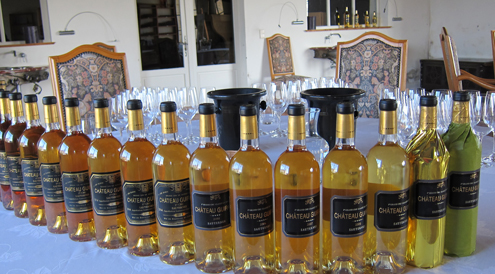The Sweet Wine Conundrum
13 April 2012
Author: Jeannie Cho Lee

Once upon a time the most expensive wines in the world were sweet. Champagne as we know it, with its fine bubbles, crisp, linear dry style was not in vogue. Instead, Champagne had noticeable residual sugar, and probably tasted more like Moscato d’Asti, the lightly sweet sparkling wine from Italy, than Brut non vintage Champagne that we are familiar with today. It wasn’t only sweet Champagne that was popular around the world, it was all sweet wines.
About one hundred years ago, people had a greater sweet tooth when it came to wine. The greatest, most expensive wines in the world were not monopolized by red wines as they are today, but included the best late harvest wines from Germany and the unctuous golden wines made from botrytised grapes called Sauternes in Bordeaux. Looking at the vines planted on steep slopes along the Mosel River or discovering the agonising way that botrytised grapes are hand-selected during multiple harvests, it is clear that the huge cost of making these sweet wines were at one time worthwhile.
I have been in Bordeaux for the past two weeks and spent a day in Sauternes and Barsac speaking with the producers whose yield per hectare would make most winery owners cry. “We had a generous year in 2011,” said Berenice Lurton, proprietor of Chateau Climens in Barsac. “The yield was about 20 hectolitres per hectare. We usually have much below that.” To compare, a first or second growth chateau would average 40 hectolitres per hectare; that is among the properties adhering to severe yield restriction employing green harvesting, sorting, etc. It is common in Bordeaux to be above 50 hectolitres per hectare.
That means a First growth Sauternes property, like Climens, Guiraud or Yquem, will produce only half of the quantity compared with a comparable vineyard size first or second growth chateau in the Medoc. Final quantity depends on weather conditions for Sauternes, more so than other wine styles because of the dependency on ‘noble rot’, or botrytis, to set in and infect the grapes. For example, no Yquem was made in 1992 because of terrible weather conditions. If you see a 1992 Yquem, you can be sure it is a fake.
Between 1991 and 1995, Chateau Guiraud bottled just over 10,000 cases of wine. That is the same quantity they would produce in a single good vintage. In 1991, Guiraud made no wine because of frost; in 1992, only 1,500 cases were produced; in 1993 no wine was produced because of excessive rain. In 1994 and 1995, Guiraud produced 4,500 cases each year.
Owner and winemaker Xavier Planty, seems serene and calm this year given that he lost 60% of the total crop to hail in 2011. At the end of April 2011, a devastating hailstorm with ice the size of small golf balls destroyed vineyards across Sauternes. “Every year is a challenge,” says Planty who has been making Sauternes for nearly four decades. “In 1984 we had a typhoon-like storm with fierce winds the first week of October and we lost 80% of the crop.” Planty remembers each vintage with perfect clarity. “In 1985, we waited and waited for botrytis to set. Finally, we harvested in December!”
Winemaking for Sauternes is just as costly as making top red Bordeaux. The first growth Sauternes and Barsac sweet wines, classified in 1855, often mature their wines in a large percentage of new barrels for 18 to 24 months. The cost of aging, holding stock and looking after the wine before it finally goes into the market is the same cost as for top red wines from Bordeaux. Yet prices have not climbed in the same way for these delicious sweet wines.
2010 Yquem for example, was released as futures in the market for around 420 Euros per bottle (ex-negociant) in 2011 while first growths like Chateau Lafite and Latour released at nearly double this price. It doesn’t help that the next most expensive Sauternes is priced at less than half of Yquem’s prices putting Yquem in a stratospheric price category for sweet wines all on its own.
Pierre Lurton who manages this legendary property said, “It is tough for Yquem and Sauternes in general because there is almost no secondary market for Sauternes.” Prices do not increase much from the time the wine is sold as futures and two years later when the wines are in bottle. What is the incentive to buy futures when you can buy the same wine at the same price two years later? Yquem is the only Sauternes chateau that makes appearances in wine auctions fairly regularly. In contrast to the others, it clearly has a secondary market.
There are still those who are willing to take the risk in Sauternes. Robert Peugeot, whose family business includes Peugeot and Citroen automotive companies, decided to invest in Chateau Guiraud in 2006. When I asked Peugeot why he bought Chateau Guiraud when the worldwide trend seemed to be away from sweet wines, he replied. “I wanted to buy a first growth property and it happened that Guiraud was available. Sauternes is not popular now but imagine when the world discovers how wonderful it is.” I don’t seen any signs yet of people moving toward sweet wines from Hong Kong and China right now, but then again, who would have predicted that China would embrace ice wine and become the largest producer of ice wine in the world?
Reprinted with permission from South China Morning Post









